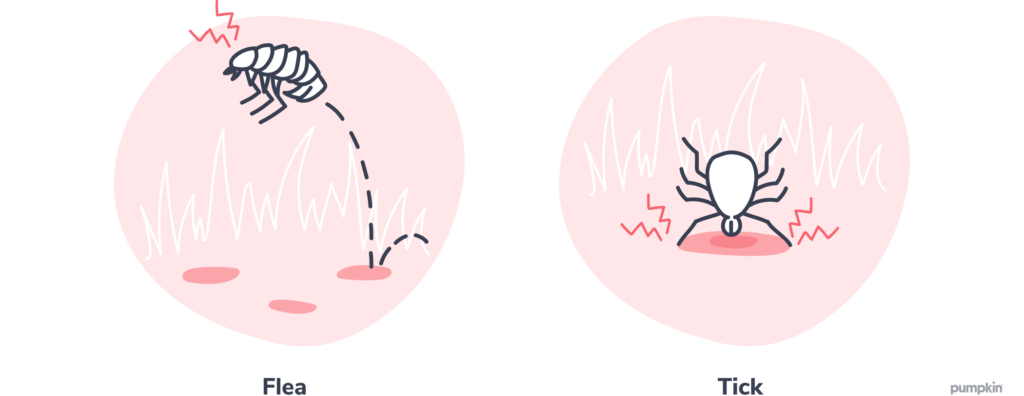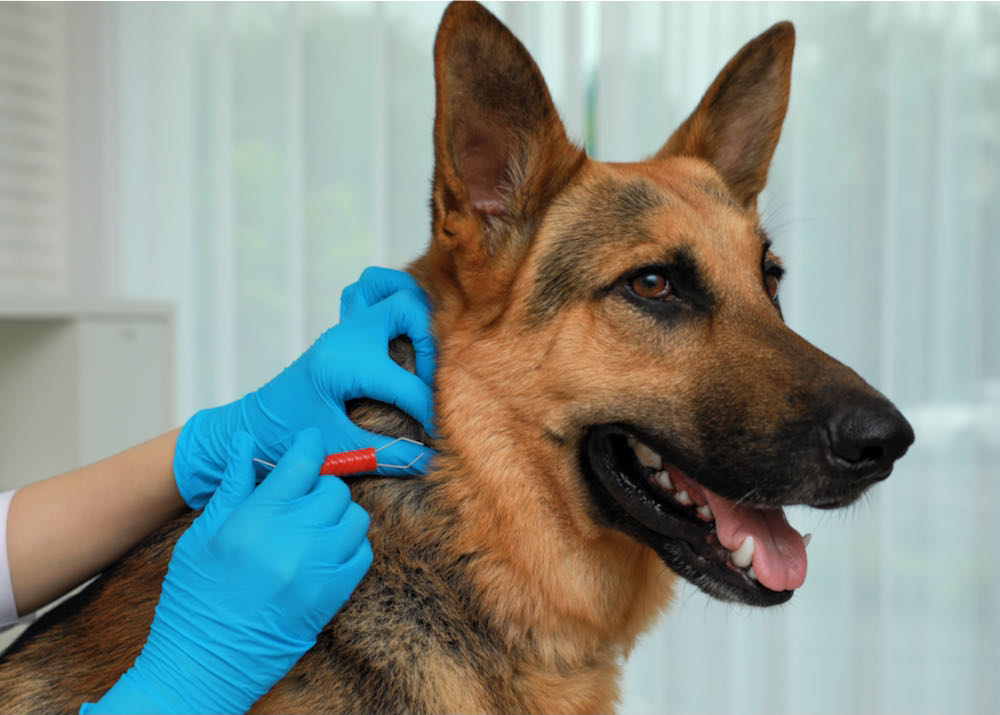- Tristan Robinson
- Jun 22, 2022
- 9 min read
Updated: Oct 30
Key Points
What's the best way to prevent fleas and ticks from bugging your dog? Regularly administer medication prescribed by your vet.
Your veterinarian will likely recommend a routine oral or topical parasiticide for all pets in the household, though over-the-counter treatments are also available.
Want to save on the costs of keeping your fur family pest-free? Join the Pumpkin Wellness Club* and you can opt to get $150 in cash for your pet's flea, tick, and heartworm prevention each year.
If you’re a dog owner, you know that flea and tick prevention is essential. These parasites can be quite a nasty surprise, as they can quickly latch onto your dog and burrow into their fur without anyone noticing.
Though smaller than a grain of rice, fleas and ticks can cause big health issues for your dog. The effects range from mild skin irritation caused by flea bites to serious tick-borne diseases like Lyme disease, ehrlichiosis, and Rocky Mountain spotted fever. These pests can also hop onto humans, infest your home, and affect other pets in your home (that means cats are at risk, too).
Are you itchy yet? Don’t panic: We asked some of our favorite veterinarians for advice on how to prevent insect-borne diseases (and stop fleas and ticks from hitching a ride into your home). Plus, with some help from the Pumpkin Wellness Club, you can even get cash back for tick and flea prevention for dogs.
Flea & tick prevention is non-optional for dog parents
No matter where you live, fleas are a fact of life for pet owners. And while it's true that ticks and canine Lyme disease are most common in areas like the Northeastern United States, these creepy crawlers aren’t letting up any time soon. In fact, the Companion Animal Parasite Council reports that ticks are spreading to previously untouched parts of the country and bringing new diseases with them.
As wild habitats and climates change, parasites like ticks and mosquitoes are more likely to expand their geographical reach, and more pets will be exposed to the diseases they carry. This means that pet owners in all parts of the United States need to take extra care to avoid fleas, ticks, and other canine parasites.
The difference between fleas & ticks

Fleas are tiny, six-legged parasites that live on their host and ingest their blood. While these little bloodsuckers lack wings, fleas can jump up to two feet in the air — pretty impressive for a bug the size of a pinhead.
Believe it or not, a female flea can lay 40-50 eggs daily and lay thousands in its life cycle. If left untreated, a single flea can cause a full-blown infestation on your dog. The bite of just one flea can cause extreme itchiness and skin irritation in some dogs. And it gets even worse: Fleas can also transmit parasites like tapeworms to your pet. If you see specks that look like dirt or coffee grounds on your pooch, this could be ‘flea dirt’ — a sure sign they’re infested.
Ticks are also small parasites that live off their host’s blood, but they are slightly larger and tend to be more visible than fleas. They have eight legs and can range from the size of a poppy seed to a sesame seed, depending on their life stage. When fully engorged with blood, they can grow to the size of a small raisin.
While fleas move and jump around, ticks pick a spot and stick to it, burrowing directly into your dog’s skin. It’s extremely important to check your dog for ticks often if you live in a wooded area or go on a lot of outdoor adventures. If a tick makes itself at home on your dog, it can transmit severe illnesses such as Lyme disease and Rocky Mountain spotted fever.
How do dogs get fleas & ticks?
Unfortunately, the answer to this question can be as simple as taking your dog for a walk. Dogs frequently encounter fleas and ticks during everyday adventures, so it’s important to check them often.
Whether your dog is frolicking at the local park, romping around in the backyard, or coming along for a hike in the woods, they can pick up fleas or ticks without your knowledge. Areas with tall grass or dense woods are especially risky for tick encounters. Fleas can jump from another infested animal to your dog, so be wary if you’re in close contact with other pets or visiting areas where wildlife is present.
Keeping your dog completely flea- and tick-free can be challenging, but there are plenty of preventive measures you can take.
Does pet insurance cover flea medication?
Unfortunately, pet insurance is a type of accident & illness coverage, and that means it can't help you pay for routine, preventive care. However, that doesn't mean you can't get help paying for tick and flea prevention for dogs.
Preventive vet care can be expensive, but the Pumpkin Wellness Club can help you save up $460 per year on your pup’s routine care and pest prevention, plus other perks like discounts on top pet brands. One membership option pays you up to $150 for money spent on prescription flea, tick, and heartworm preventives each year (for reference, most of these medications cost between $30-40 for a 1-month supply). You can also get paid cash for routine blood tests to screen for related infections, annual checkups, fecal testing, and vaccinations.
How to protect your dog from fleas & ticks
So, how do you keep your pets safe and your home bug-free? You can prevent these pests from landing on your dog in the first place, or treat the infestation after it happens — most dog owners will prepare for both stages of prevention and treatment just in case.
Let’s get into the best vet-recommended methods for preventing fleas and ticks from bugging your pet. As always, talk to your veterinarian before starting your pet on any medication. Some topical preventives and treatments are prescription-only, and your vet will know what's best.
Oral parasiticides
A monthly chewable parasiticide (such as Simparica Trio) will kill both fleas and ticks before they can reproduce or spread disease. It also has the added benefit of protecting your dog from heartworms, hookworms, and roundworms — all you need to do is see your veterinarian for a prescription.
Routine, prescription-strength medications designed to kill multiple kinds of parasites will provide the best defense against fleas, ticks, and related infections.
Topical parasiticides
Spot-on or topical medication is another popular option for preventing fleas and ticks from latching onto your pet. These products usually come in drops, and you should apply them to your dog’s skin on a routine basis, such as once a month.
Similar to tick and flea collars, topical parasiticides contain chemicals that repel and kill ticks, fleas, and in some cases, mosquitoes. You only need to apply the drops to one spot — usually between the shoulder blades — for the medicine to reach your dog’s sebaceous glands. These oil-producing glands are located just under the skin and will gradually release the medicine from within, even if your dog gets wet.

Tick and flea collars
Flea and tick collars can be a good option alongside routine parasiticides, especially for those who live in heavily wooded areas.
There are two types of protective collars: one that releases a substance that repels and kills adult fleas and ticks, and another that deposits a chemical repellent into your dog’s sebaceous glands (similar to topical medication) for longer-lasting prevention.
However, it’s extremely important to do your research and discuss this preventive method with your vet first. Some flea and tick collars contain chemicals that can be dangerous to you and your pet’s health, so ask an expert before you buy.
All-natural spray
If you prefer an all-natural solution, you can consider essential oils for dogs, though we don't recommend it. While essential oil or permethrin sprays can aid in flea and tick prevention, remember that they are typically much less effective than the solutions listed above. Plus, not all dogs will do well with alternative options. Talk to your vet if you’re interested in learning more about all-natural flea and tick prevention options.
What are popular flea and tick treatments for dogs?
Some of the most popular flea and tick treatments include:
Simparica Trio chewable tablets for dogs: These FDA-approved prescription chews protect against fleas, ticks, and worms, including heartworms, roundworms, and hookworms
NexGard Chewables: Chews that kill adult fleas and black-legged ticks
Seresto flea and tick Collars: This brand makes popular flea/tick collars for dogs and cats
Bravecto topical solution: This prescription treatment (active ingredient fluralaner) kills fleas and ticks for up to 12 weeks
Frontline Plus: A popular over-the-counter topical treatment in the form of drops
K9 Advantix II: Topical drops that repel and kill ticks, fleas, and a variety of other biting insects
Bravecto: A prescription brand that makes flea/tick chewables and topical treatments
Many of the best flea and tick treatments also protect against other pests, including parasites like worms and disease-carrying bugs such as mosquitoes. Not sure about the right treatment for your favorite pup? As always, talk to your veterinarian for personalized recommendations.
While adverse reactions to flea and tick treatments are rare, they can happen. Whenever you're introducing new pet products, watch closely for signs of unexpected side effects or allergic reactions.
How can I tell if my dog has fleas?

As gross as it may be, you should do a thorough check if you suspect your dog may have fleas. Fleas tend to hang out in your pet's nooks and crannies: think behind the ears, at the base of the tail, in the armpits, and inside any skin folds. If you look closely, they are (just barely) visible to the naked eye.
Keep an eye out for these signs that your dog might be suffering from a flea infestation
Biting or scratching at their skin
Irritated areas or ‘hot spots’
Irregular hair loss
Visible fleas, flea eggs, or flea dirt
Removing fleas with the paper trick
If your pooch seems uncomfortable and you suspect fleas, it’s time to grab a flea comb and a piece of white paper.
With your dog cozy and relaxed, hold the white paper under the area you want to check. Gently comb through your pup’s fur for tiny black specks that look like dirt. Found some? Move those specks onto a separate, damp piece of paper and wait for the magic to happen.
In no time, the specks will transform from black to red as they process the blood they’ve stored. Unfortunately, that means your pup has fleas and you need to consult with your vet. But if the specks stay dark and black, it’s likely just dirt, and you can breathe a sigh of relief.
How can I tell if my dog has ticks?

If you feel a small lump under your dog’s fur or spot a bulbous black dot, it could be a tick. Unlike fleas, ticks remain latched and can grow in size the longer they remain on your dog’s skin. Ticks can remain embedded for as little as two days to as long as two weeks (not-so-fun fact: ticks actually release anti-clotting agents via their bites, which allows them to keep feeding on your pet’s blood for as long as they please).
Ticks can latch onto pretty much any part of your dog, and they aren’t picky. Make sure to check your dog’s full body for ticks, including between the toes, inside the ears, and under the collar.
Some ticks carry infectious diseases, and they can pass them to your pup. This can occur even after the tick has been removed. Keep an eye out for symptoms of Lyme disease, which include lethargy, loss of appetite, and swollen joints. If you suspect the symptoms are related to a tick bite, however recent, bring your dog to the vet ASAP.
Removing a tick from your dog
If you find a tick, stay calm and grab a pair of fine-tipped tweezers or a special tick removal tool. You’ll also need some gloves, rubbing alcohol, and a lidded container where you can deposit the tick.
Gently grasp the tick near its head with the tweezers, close to your dog’s skin, and pull it straight out. Be careful not to rush the process: Yanking or pulling on the tick may cause you to remove the body but leave the head embedded in the skin, where it can release disease-causing agents into your pet’s bloodstream. The tick should loosen its bite when it feels pressure, allowing you to remove it intact.
Be sure not to leave any parts of the tick behind! Any bits left under your pet’s skin can cause infection, and trying to dig them out will only make it worse. If you think the head is still embedded, call your local veterinarian for advice. After you have fully removed the tick, clean the area with disinfectant and save the tick in a plastic bag to bring to the vet for testing. For a step-by-step guide, read more about how to get a tick off your dog.
The final word on preventing fleas and ticks
When in doubt, speak with your vet about flea and tick prevention options. They are the best source of knowledge when it comes to your dog’s health. Remember: Not only do these treatments keep your dog safe from skin-tingling parasites, but they also lower your dog's risk of suffering from diseases such as canine Lyme disease and heartworm disease.
And don’t forget to check out the Pumpkin Wellness Club for up to $460 in annual savings for routine vet care like flea and tick treatment, special discounts on pet products, and access to a 24/7 pet health helpline.




